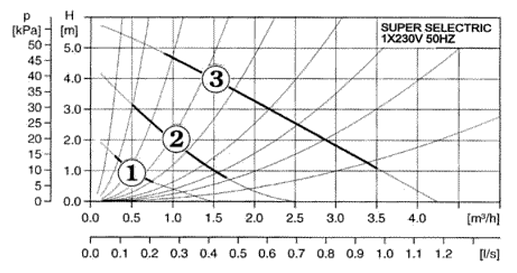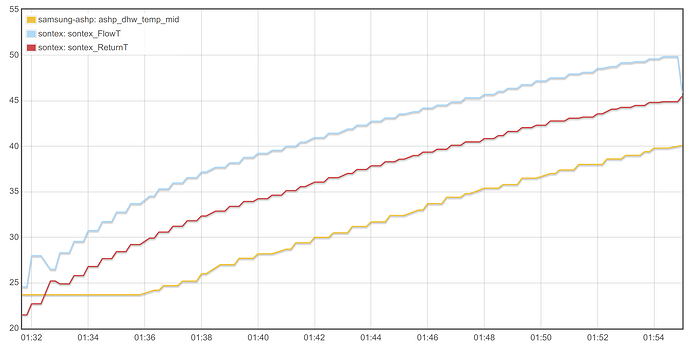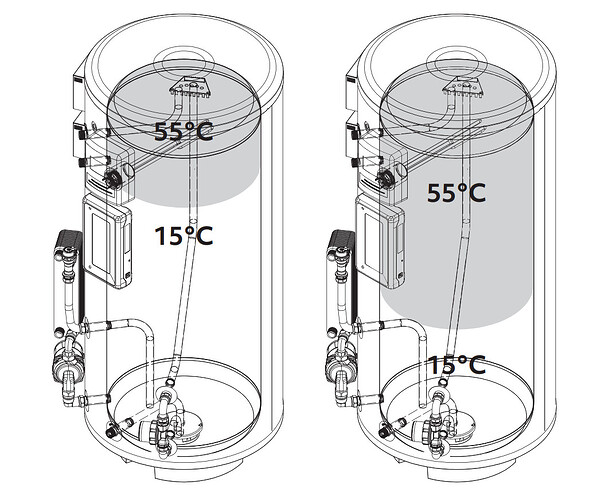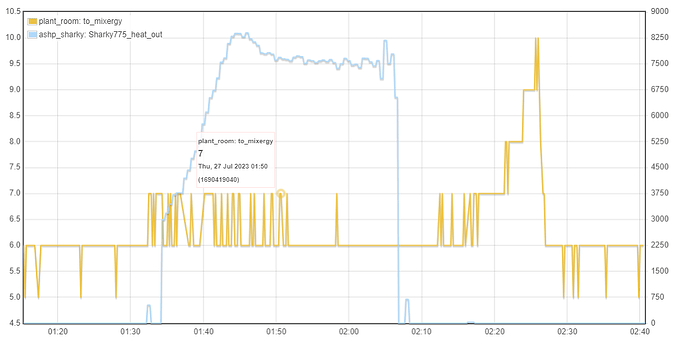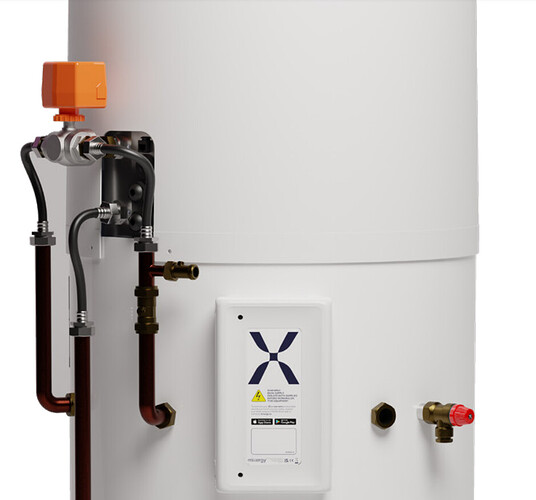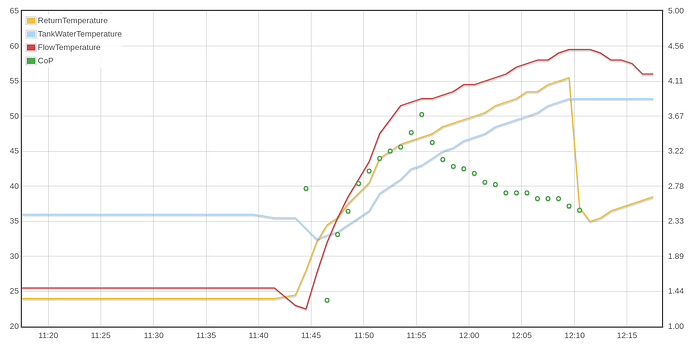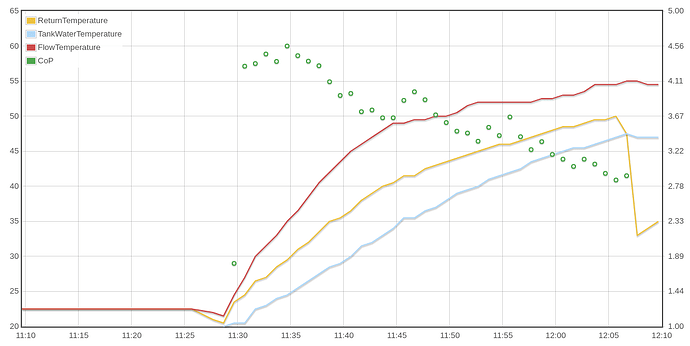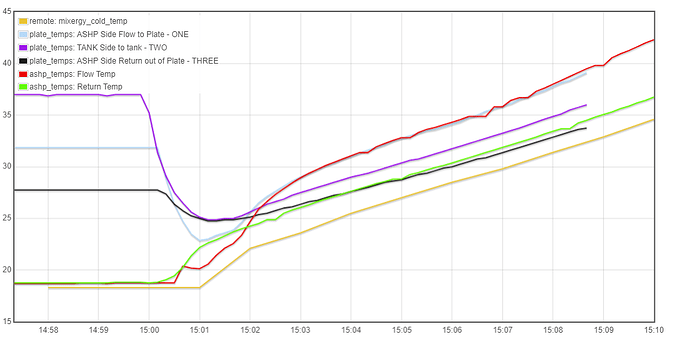I can’t find a datasheet that exactly matches the pump model I have (Grundfos UPS0 15-60 CIL2), but this chart suggest a huge difference in flow between the different settings. A factor of 2 or 3 perhaps:
ecocirc M 15-6-130 N.pdf (2.6 MB)
Oooh, pump info from Lowara.
You can set it to anything via API ![]() It’s only the web/app interface it’s limited.
It’s only the web/app interface it’s limited.
I know you can still poke 65C at it via the API (and Toms home assistant integration) even after they lowered to max from 65C down to 60C in the app. It will still heat to 65C.
But I’ve not tried lowering it to 45C (lower than the current 50C limit). Does that work?
I might ask Tom to put that 45C option in his integration. ![]()
My view on efficiency is that Mixergy PHE has a disadvantage over some cylinders with coils because of the circulation pump. This is primarily an issue when reheating the tank from anything other than almost empty. The mixing caused by the pump will mean that in these cases the starting temperature will likely be higher than a cylinder with good stratification and a heat pump coil near the bottom of the tank.
This starting temperature (considering mixing) along with i) outside temperature ii) target flow temperature iii) having a big enough coil/PHE iv) ASHP DHW mode, is what is going to drive the resulting COP more than tweaks to flow rates, which likely already have sensible defaults, IMO. The PHE, which is rated at 44kW, isn’t in itself the issue I don’t think.
Which are the installs that are performing significantly better than yours?
- The CustomRenwable install you referenced on Twitter is getting 2.7 not 3.4.
- Adam is getting very good COP, but looks like his starting temp is lower and he only seems to be heating the tank to 45C.
Try emptying your Mixergy to 0% and then heating it to 45C on a 20/25C day on “eco”, and see what COP you get. I reckon you’ll get close to 5, especially given 5kW unit is more has a better COP (6.6!) at A20W35 than the 7kW unit.
BTW, Looking at the design for the Mixergy iHP, it seems they have taken a different approach to circulation to (optionally?) get around the mixing issue: Introducing Mixergy’s new award-winning heat pump cylinder, the iHP • Mixergy
On full power 5.7kW I get
- Flow - Cyl (middle) = 11k
- Return - Cyl (middle) = 6k
It seems quite clear that my small 1m2 coil (compared to Trystan’s 3m2(ish?) coil) requires a higher flowT to reach a given tankT. This DHW run increased tankT from 24C - 40C
This run got a COP of 4.2 with an outsideT of 10C
Yes! I wouldn’t suggest it if I hadn’t already done this via API.
I was playing around with this when I still had the top/primary coil plumbed in. I was trying to heat the tank to 35C with the top coil, then 40C, then 45C etc. as a way of overcoming the inefficiencies with using the top coil. It worked, and improved COP, but wasn’t very practical even though I tried to automate it via Loxone. I then switched to the PHE which is giving better COP, but on the flip side, I have more losses as it is always filling the tank whereas before I could partially charge to 60% most days. Also, it’s annoying that if the tank has 20% left at 6 pm I can’t top it up to 40% with ASHP a little bit, it’s everything (on expensive tariff) or nothing (and wait until 2 am cheap tariff), top coil worked nicely in this scenario.
Thanks Daniel, appreciate the great insights.
Looking at many on the heatpumpmonintor list, most of them outperform mine
4.8COP, heating to 50C at 16C outside
https://emoncms.org/app/view?name=MyHeatpump&readkey=b458b9d6cc90ffafd5722dcd010e38da
3 COP, heating 70C at 16 outside (70C!)
https://emoncms.org/app/view?name=MyHeatpump2&readkey=0c28f25dea9e38f983d9c83a6dd455c0
Glyn, COP 4.3, heating to 45C at 13C outside
https://emoncms.org/samsung5kw
3.7 COP, heating to 48C at 17C outside
https://emoncms.org/app/view?name=My+Heatpump&readkey=8e2d4547934319f9151a4730fb3e9f21
Trystan 4.7 COP, heating to 4.7 at 17C outside
https://emoncms.org/midterrace
This does hold up, you’re right. I do get better COP when the tank is emptier.
More than 50% full upto 100% gives worse COP than 25% to 100% for example.
I wonder if there are any software / circulation pump tweaks they could do to mixing strategy?
Any what is this from their website? ![]()
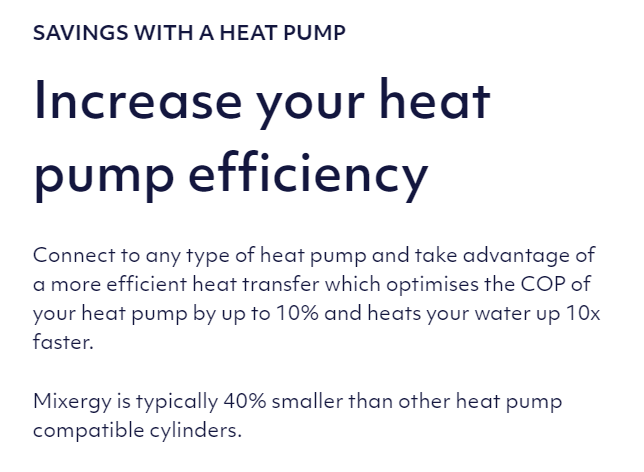
I wonder if there are any software / circulation pump tweaks they could do to the mixing strategy?
I don’t see how there could be unless the circulation pump is plumbed in differently.
Did you see this note in the iHP details:
This fast reheat process from Mixergy allows for a quick boost with more than twice the efficiency of a direct electric heating element. On the other hand, the system can opt for the highest system efficiency (COP ~3.5+) through whole cylinder heating via the boost divert valve.
This looks to be an approach for doing circulation differently to keep ASHP flow temperature lower for longer. It’s lacking in details though. Worth asking Mixergy for more details on this approach and if/how/when such an approach could be taken with the standard Mixergy tank.
How many of these are coils rather than external plate HEx?
If you ignore the spike at the end, which isn’t going into the tank, this is only actually 2.67.
Don’t get stuck on the 2.7 figure, it’s actually 3
That useless blip it’s just .3-.4 difference in COP of the 70C heating cycle only.
For the usual 55C the COP is between 3 and 4.5, these days, without any blips.
Surely if you want to compare you need to find the right data, with same exact temperatures.
Here’s some interesting detail from last nights hot water run.
- Red is electric input (watts) from my Vaillant controller (which drives the external mixergy plate pump)
- Yellow is the electric input (watts) from the Mixergy (which drives to pump on the bottom right, the normal churner pump) - same scale as the controller (scale on left)
- Blue is the heat output (watts) from the heat meter (scale on right)
So the PHE pump drives like mad (40 odd watts) for the full duration of the DHW run.
It looks like the other Mixy pump doesn’t really do anything major until 15 mins after the DHW finishes (green circle).
Although it’s hard to tell whether the external pump kicks in on a low setting as there is only a few watts increase.
Although this snapshot without the PHE plate shows something is happening? Maybe the CT clamp can’t pick it up properly at such low watts?
Mixergy Datasheet - IHP STANDARD - v01.pdf (600.6 KB)
Email enquired, coming in September
Interesting, as it seems to show the PHE only circulating water at the bottom of the tank. If this is the case, there shouldn’t be large amounts of mixing. (Unless the pump running at a high speed stirs things to some extent).
The second (non-PHE) pump AFAIU only runs when using the immersion heater or top coil. This is because it’s only required to spray cold water into the top of the tank when heating using one of these two methods.
Interesting to see how Trystan’s system (with coils) performs compared to my system (heat exchange) when the temperature of the tank is warmer than the starting temperature of the ASHP loop.
With my system, the return temperature is actually higher than the flow temperature for the first few minutes, as ASHP circuit steals (borrows) heat from the cylinder until the compressor takes over.
The overall COP (2.8) is lower than if the bottom of the tank starts colder (3.6) (excluding standby).
- July 27th, 20°C ambient, water heated to 52.5 °C, 0.9 kWh electricity => 2.5 kWh heat

- July 28th, 20°C ambient, water heated to 47.5 °C, 1.4 kWh electricity => 5.0 kWh heat

This phenomenon is discussed in the thread Improve efficiency: Heat the hot water when it’s cold.
I might tweak my system so that it doesn’t try heating DHW at all if the bottom of the tank is still warm…
Do you see the same thing happening with Mixergy?
